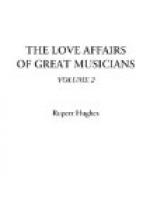Similarly the public came to the aid of Robert Franz, before his death, thanks to Liszt and others. For Franz, who had married the song composer, Marie Hinrichs, lost his hearing and drifted to the brink of despair before a series of concerts rescued him from starvation.
Heinrich Marschner was married three times, his latter two wives being vocalists. Thalberg married a daughter of the great singer Lablache; she was the widow of the painter Boucher, whose exquisite confections every one knows. They had a daughter, who was a singer of great gifts.
Meyerbeer in 1825 lost his father, whom he loved to the depth of his large heart. At the father’s death-bed he renewed an old love with his cousin, Minna Mosson, and they were betrothed. Niggli says she was “as sweet as she was fair.” Two years later he married her. She bore him five children, of whom three, with the wife, survived him and inherited his great fortune.
Josef Strauss, son of a saloon-keeper, married Anna Streim, daughter of an innkeeper. After she had borne him five children, they were divorced on the ground of incompatibility. How many children did they want for compatibility’s sake? Their son Johann married Jetty Treffy in 1863; she was a favourite public singer, and her ambition raised him out of a mere dance-hall existence to the waltz-making for the world. When she died he paid her the exquisite compliment of choosing another singer, before the year was over, for the next waltz. Her name was Angelica Dittrich.
Joachim Raff fell in love with an actress named Doris Genast, and followed her to Wiesbaden in 1856; he married her three years later, and she bore him a daughter.
The Russian Glinka was sent travelling in search of health. He liked Italian women much and many, but it was in Berlin that he made his declarations to a Jewish contralto, for whose voice he wrote six studies. But he married Maria Petrovna Ivanof, who was young, pretty, quarrelsome, and extravagant. She brought along also a dramatic mother-in-law, and he set out again for his health. His wife married again, and the scandal of the whole affair preyed on him so that he went to Paris and sought diversion recklessly along the boulevards.
His countryman, Anton Rubinstein, married Vera Tschekonanof in 1865. She accompanied him on his first tour, but after that, not.
The Bohemian composer Smetana married his pupil, Katharine Kolar; he was another of those whose happiness deafness ruined. He was immortalised in a composition as harrowing as any of Poe’s stories, or as Huneker’s “The Lord’s Prayer in B,” the torment of one high note that rang in his head unceasingly, until it drove him mad.
FRANZ SCHUBERT
Among the beautiful figures, whom the critical historian tries to drive back into that limbo, where an imaginary Homer flirts with a fabulous Pocahontas, we are asked to place the alleged one love of Schubert’s life. Few composers have been so overweighted with poverty or so gifted with loneliness as Franz Schubert. His joy was spasmodic and short, but his sorrow was persistent and deep.




